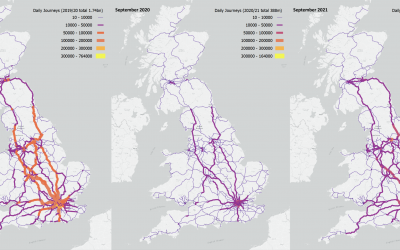An Evolving UK Enterprise Market: The New Technologies and Innovations Reshaping B2B Communications
The UK enterprise market has experienced a remarkable evolution over the past few decades, propelled by technological advancements and the increasing digitisation of business operations. This transformation has brought about a wave of optimism, promising a future of enhanced efficiency and productivity.
Amidst this transformation has been the remarkable evolution of B2B communications.
Seizing the Future of Telecoms: The Continuing Ascendancy of MVNOs
Mobile Virtual Network Operators (MVNOs) have carved out a niche transcending traditional mobile service boundaries. Agile and powered by innovation, MVNOs have leveraged the infrastructure of existing carriers to redefine service delivery and bring customised solutions to an increasingly diverse consumer market.
As 2024 matures, the ecosystem in which MVNOs operate has become characterised by rapid technological advancements, shifting consumer expectations, and a restless regulatory environment. It has created fertile ground for MVNOs to expand their horizons and tighten their grip on the industry.
Mobile World Congress 24 – the key takeaways
The mobile industry’s flagship annual conference returned to Barcelona for 2024, with more than 100,000 in-person delegates attending Mobile World Congress 24. The themes of the conference spread right across the sphere of connectivity, but one topic dominated above all others – Artificial Intelligence.
UK Gigabit Broadband and 5G Rollout in Need of More Collaboration
A recent study by the Digital Connectivity Forum (DCF), a leading industry think-tank, suggests that the UK’s deployment of gigabit broadband and 5G mobile networks could be enhanced through better communication, collaboration, and consistency between local authorities and the telecommunications sector.
Currently, more than 76% of UK properties have access to a fixed gigabit-capable broadband ISP network. However, this number drops to 53% when considering only FTTP connections, with the gigabit figure inflated by Virgin Media’s Hybrid Fibre Coax network. Furthermore, Ofcom’s recent data shows that 5G outdoor coverage from at least one provider reaches 73-82% of UK properties. Yet, when evaluating outdoor coverage offered by all operators collectively, this percentage significantly drops to between 12-22%.
AI and Telecommunications: A look at the present and the future
Since Alexander Graham Bell sat at an ornate desk in sepia-tinted 1892 New York and placed the first-ever phone call to Chicago, the telecommunications industry has stood at the forefront of technological innovation. As the crowd watched in disbelief as Bell spoke with another human being over 700 miles away, few could have guessed what the next 130 years were to have in store.
Today, amidst a digital telecoms carnival of mobile, 5G, VoIP, instant messaging, and video-conferencing, a new technology is quietly transforming the way we communicate all over again: AI.
Challenging Traditional Strategies: Becoming a Disruptive MVNO in the IoT Market
Across the constantly evolving telecommunications landscape, Mobile Virtual Network Operators (MVNOs) have established themselves as innovative players, unafraid of challenging the status quo.
In few areas has their appetite for disruption become more apparent than their ongoing advance on the Internet of Things (IoT) market. Indeed, the global IoT MVNO market is already valued at around $2.9BN and is expected to post revenues of almost $7BN by the close of 2028.
Are hyperscalers ‘free riding’ on the mobile industry’s investments?
In recent weeks, a row between Big Tech and European telecoms operators has begun over who should be responsible for funding the rollout of 5G and broadband. It is a clash that drew in the European Union, who have so far taken a neutral position.
Referencing a 12-week consultation recently launched by the European Commission, EU industry chief Thierry Breton signalled that the bloc is taking an open-minded approach to the issue of ‘fair share’ and who picks up the tab for 5G and broadband network rollout in the future.
What the GSMA Open Gateway initiative means for mobile carriers
In partnership with 21 carriers, the GSMA Open Gateway initiative proposes a framework to provide universal, open-source application programming interfaces (APIs) into carrier networks.
The intention is that developers can access a variety of mobile network services, such as location, identity verification, and carrier billing, that all would once have been too complex or costly to integrate and utilise.
Forecasting demand for mobile connectivity on Great Britain’s railways
The last three years with Covid-19 and lockdowns has profoundly impacted all walks of life. On the railways this appears to have fundamentally shifted passenger demand, with the Office Rail and Road noting that the annual number of journeys has yet to recover to pre-pandemic levels.
Our client wanted to understand how these changes may impact current and future geographical demand for rail passenger mobile connectivity. With a choice of technical interventions – ranging from addressing “not-spots” only, through to dedicated infrastructure solutions – establishing the baseline requirements is an important first step in the development of policy.
Improving mobile connectivity on GB railways
We all know how poor mobile phone connections, and the on-train wifi that relies on these too, can be when travelling by train.
Apart from the obvious signal blockers like deep cuttings and tunnels, trains run through rural areas with few villages, towns or roads and hence little incidental mobile coverage. Add in busy trains (at least pre-pandemic), carrying the equivalent of a small village worth of people all attempting to connect to their nearest mobile operator’s cellular basestation, and its unsurprising that Transport Focus [1] found that passengers only receive a good 4G connection some 58 per cent of the time.
2022 is set for another year of innovation and growth for the MVNO sector
2021 was a thundering year for the MVNO sector as its market size hit US$ 73.3 billion. Furthermore, forecasts were made that the industry is set to register a CAGR of 7.5% between 2022 and 2030, taking it to a staggering US$ 140.2 billion.
Of course, 2021 was also a year that was heavily influenced by the pandemic. A notable upshot of the various lockdowns was amplified consumer expectation for digital experiences and the emergence of new mobile behaviours.
What the coming together of 5G and cloud computing could mean for both the industry and consumers
In a landmark development in the relationship between the two tech giants, it was announced in July that AT&T – the world’s largest telecoms company, and the second largest provider of mobile telephone services – will transfer management of its mobile network traffic over to Microsoft Azure, beginning with their 5G core.











